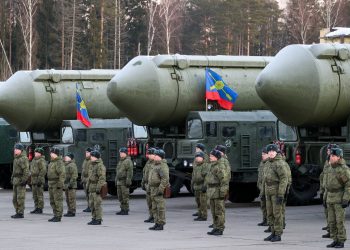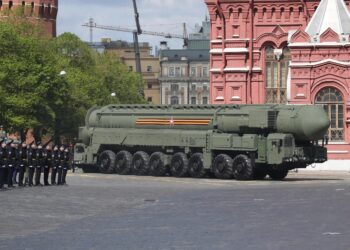,
Isfahan, Iran (AFP): Nothing seems extraordinary on the quiet provincial road outside the ancient Iranian city of Isfahan. Then suddenly, nestling beneath the mountains, a tall chimney emerges flanked by an impressive complex of buildings. This is the Iranian plant for converting uranium, a centrepiece of the Islamic republic's nuclear programme, and rarely opened up to outsiders.
Here Iran converts uranium into the gas that can then be fed into centrifuges to make enriched uranium, a substance that can be used to make both nuclear fuel and in an atomic bomb.
Driving along, there is little indication of the strategic importance of the verdant 60 hectare complex except a raft of yellow “No Photo” signs and occasional anti-aircraft artillery guns.
But then the mass of security officials waiting at the entrance betrays the importance of the site, just 15 kilometres (9 miles) outside Isfahan, Persia's former imperial capital and a jewel in Iran's tourist crown.
Visits by journalists are almost unknown at the highly protected site but on Saturday dozens were bussed in from Tehran as Iran seeks to prove to the outside world that its controversial nuclear programme is transparent.
“This is the maximum transparency you can imagine that a country can have,” said Iran's ambassador to the UN nuclear watchdog Ali Asghar Soltanieh before taking journalists and visiting envoys on a tour of the site.
“It shows that the government of the Islamic Republic of Iran pays due attention to the public opinion of the international community,” he added.
Before being allowed into the heart of the conversion plant, journalists were told not to “overstep the boundaries” and observe a formal ban on taking pictures of the site's exterior.
Then the assembled foreign and domestic media were given white protective clothes and headgear, as distinct from the blue clothing handed to the visiting International Atomic Energy Agency (IAEA) envoys.
Hit by UN Security Council sanctions over its atomic programme and vehemently denying US allegations it is seeking a nuclear weapon, Iran is keen to prove its activities are clear and transparent.
Its decision to open the doors of the Isfahan plant also comes amid mounting Western pressure for Tehran to halt uranium enrichment activities or face further consequences.
How much can be interpreted from such a visit by nuclear non-specialists is debatable however, and Cuban ambassador to the IAEA Norma Estenoz said afterwards that it was for other specialists to make conclusions.
The site is marked by gleamingly clean white corridors leading to halls filled with complex aerial piping and tanks marked with chemical names like “T2-AP Aluminum Carbide, 20 percent”.
At the Isfahan site, uranium yellowcake made from raw mined uranium is turned into UF6 gas, from which enriched uranium is produced.
The latter process takes place at Iran's plant in the town of Natanz, 100 kilometres (60 miles) north of Isfahan, a site arguably even more sensitive than the conversion plant that was not included in the tour.
Soltanieh, like everyone dressed with protective clothing over his suit, proudly showed reporters the chamber were the UF6 is made under the beady eye of IAEA camera surveillance.
“Please do not touch anything but we want you to see for yourself that the cameras are on 24 hours a day and are monitoring everything,” he said, before leading the assembled media into the hall.
An AFP correspondent observed two IAEA surveillance cameras keeping watch over the scene, taking pictures at regular intervals to ensure no UF6 leaves the room unaccounted.
“The whole system is a closed system. This means that every gramme is calculated by the IAEA. Therefore they can have accountancy very easily,” said Soltanieh.
“Two hundred and fifty tonnes (of UF6) have been produced here and everything is under the control of the IAEA.”
He also espoused the safety of the leftover products of the process. “There are no environmental problems. Whatever is left over can be used in any garden.”
Soltanieh said the visit would give the visiting envoys and the media the chance “to see for themselves what is going on in the peaceful nuclear activities of Iran”.









